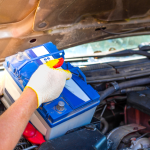Taking care of your car’s tires is one of the simplest yet most overlooked aspects of vehicle maintenance. Many people focus on oil changes, brake checks, and engine tune-ups but forget that their tires play a critical role in the overall health of the vehicle. One of the most essential and easy ways to maintain them is by rotating tires on a regular basis. This article will explore why this routine practice is crucial for every car owner.
The Basics of Rotating Tires

Rotating tires refers to the process of periodically changing the position of each tire on your vehicle. The primary reason for doing this is to ensure even wear on all four tires. Typically, the tires in the front experience different forces compared to those in the rear. For example, if you drive a front-wheel-drive vehicle, the front tires are responsible for steering, acceleration, and most of the braking, which causes them to wear out faster. By rotating tires, you allow all of them to share the burden, extending their lifespan and improving overall performance.
Regularly rotating tires also has other benefits, such as enhancing fuel efficiency and providing a smoother, safer driving experience. Despite these clear advantages, many drivers neglect this crucial aspect of vehicle maintenance.
How Often Should You Be Rotating Tires?
When it comes to how often you should be rotating tires, there are several factors to consider. The general recommendation is to rotate them every 5,000 to 7,500 miles. However, it’s always best to check your vehicle’s manual for the manufacturer’s advice. If you drive under extreme conditions—like frequently hauling heavy loads, off-roading, or driving on poorly maintained roads—you might need to rotate your tires more often.
In some cases, your tires may show signs that it’s time to rotate them. Uneven tread wear, noticeable vibration while driving, or a pulling sensation to one side could indicate that your tires are wearing unevenly, signaling the need for rotation. By keeping a close eye on these signs, you can ensure that you’re rotating tires at the optimal time for your vehicle’s specific needs.
Extending the Life of Your Tires
One of the most significant benefits of regularly rotating tires is the extended life you get out of them. Tires are not cheap, and by ensuring even wear, you are maximizing the value of your investment. Unevenly worn tires wear out faster, which means you’ll be replacing them sooner than necessary. Over time, the cost of failing to rotate tires can really add up.
Think of your tires as a team. If you overwork two of them while the other two remain relatively fresh, you’re going to run into problems. By rotating tires, you’re ensuring that every tire has a chance to contribute equally to the vehicle’s performance, which can significantly delay the need for a full set of replacements.
Improved Fuel Efficiency
Rotating tires doesn’t just save you money on replacements; it can also save you money at the gas pump. When tires wear unevenly, they don’t make uniform contact with the road, leading to increased rolling resistance. This means your engine has to work harder to move the vehicle forward, consuming more fuel in the process.
By rotating tires regularly, you ensure that all four tires wear evenly, which helps maintain optimal contact with the road. This reduces rolling resistance and allows your vehicle to operate more efficiently. As a result, you’ll notice an improvement in fuel economy, which is particularly beneficial in today’s world of fluctuating fuel prices.
A Smoother, Safer Ride
Your car’s handling and overall performance are directly affected by the condition of your tires. When tires wear unevenly, it can lead to a rough, uncomfortable ride. Vibrations, especially at high speeds, are a telltale sign that your tires aren’t wearing evenly. Rotating tires helps prevent this uneven wear, ensuring that your ride remains smooth.
But more importantly, tire rotation improves your vehicle’s safety. Unevenly worn tires can reduce traction, especially in adverse weather conditions like rain or snow. This increases the likelihood of hydroplaning or losing control on slippery surfaces. By regularly rotating tires, you ensure that all four maintain consistent traction, which enhances overall safety, particularly during emergency maneuvers or in challenging driving conditions.
Protecting Other Components of Your Vehicle
Beyond just improving the longevity of your tires, regularly rotating tires can protect other critical components of your vehicle. Uneven tire wear can place extra stress on your suspension system, alignment, and even the drivetrain. Over time, this additional strain can lead to more serious and expensive repairs.
For example, uneven wear can cause your suspension system to compensate for the imbalance, leading to premature wear of shock absorbers and struts. The constant jarring from uneven tires can also affect your vehicle’s alignment, causing your car to pull to one side and increasing the risk of accidents. By rotating tires, you’re ensuring that the rest of your vehicle’s components are working under optimal conditions, reducing the likelihood of expensive repairs down the road.
Tire Rotations and All-Wheel Drive (AWD) Vehicles
Many drivers of all-wheel-drive (AWD) vehicles might think that rotating tires isn’t as important for them. However, this is a misconception. While AWD vehicles distribute power to all four tires, they can still experience uneven wear. In fact, if the tires aren’t rotated regularly, the difference in wear between the front and rear tires can strain the AWD system, potentially causing damage.
For AWD vehicles, it’s particularly important to follow a strict schedule when rotating tires. By doing so, you’ll not only extend the life of your tires but also protect your vehicle’s AWD system from unnecessary stress.
The Role of Professional Maintenance
While rotating tires may seem like a simple task, it’s best performed by a professional. Tire rotation is often bundled with other services such as alignment checks and tire balancing, both of which are crucial for ensuring that your tires perform at their best. A mechanic can also inspect your tires for any signs of damage, such as punctures, cracks, or uneven tread wear that might indicate deeper issues with your vehicle.
Professional tire rotation ensures that the tires are rotated in the correct pattern based on your vehicle’s specific needs. Different vehicles require different rotation patterns, depending on whether they’re front-wheel, rear-wheel, or all-wheel drive. Additionally, if your vehicle has directional tires or tires with staggered sizes, a professional will know how to handle these specific requirements.
Don’t Forget About Tire Pressure
When rotating tires, it’s also a good time to check your tire pressure. Maintaining the correct tire pressure is essential for achieving even wear and improving fuel efficiency. Underinflated tires can lead to increased rolling resistance and uneven wear, while overinflated tires are more prone to damage and reduce traction.
By routinely checking tire pressure—along with rotating tires—you ensure that your tires are wearing evenly and performing optimally. This simple step can significantly extend the life of your tires and improve your vehicle’s overall efficiency.
Conclusion
Rotating tires is a simple, yet incredibly effective way to extend the life of your tires, improve fuel efficiency, and enhance your vehicle’s overall performance. By evenly distributing the wear across all four tires, you’re ensuring that they last longer, provide a smoother ride, and offer better traction on the road. Neglecting this essential maintenance task can lead to uneven wear, increased fuel consumption, and even costly repairs to other components of your vehicle. Ultimately, regularly rotating tires is a small investment of time and effort that pays off in significant savings and safety benefits in the long run.










